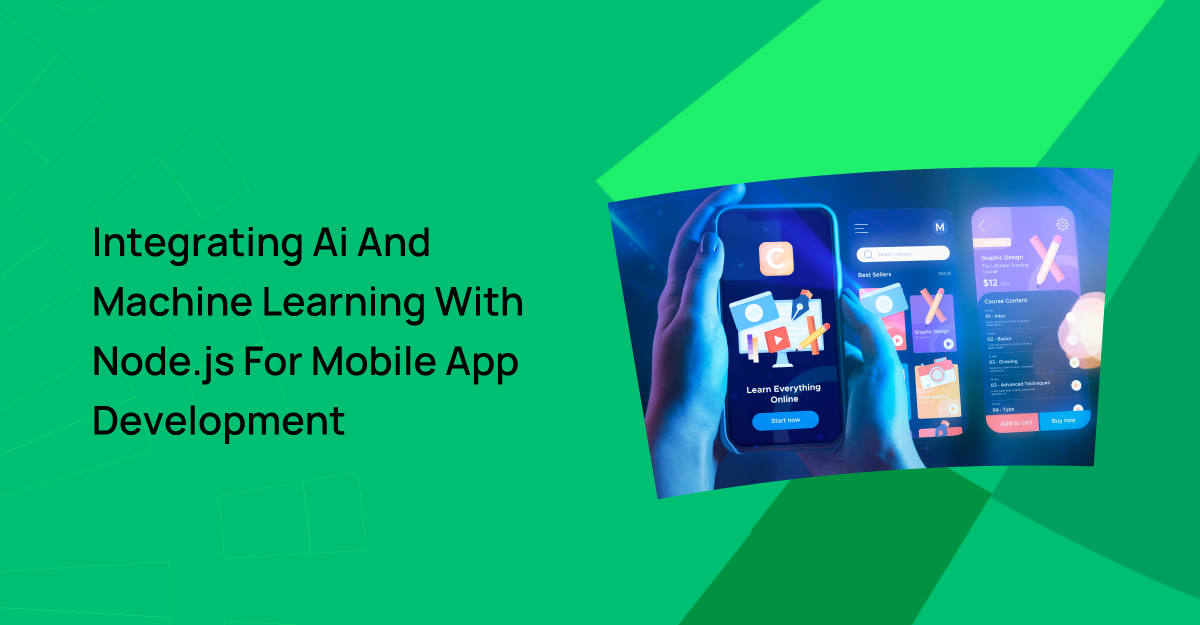Machine learning (ML) has grown significantly over the past several years and is now used more often across a variety of sectors. JavaScript is becoming the standard language for web development due to its versatility and wide use. ML capabilities are now being readily included in Node.js apps by developers. Here, we'll go in-depth on how to successfully integrate AI and ML into the creation of node.js mobile development.
A Perfect Match: AI and Node.js
JavaScript has advantages over Python for developing, and because it can handle speech, written text, and graphics, Node.js is appropriate for containers and IoT devices. Node.js runs models locally using JavaScript, which may also make browser programs more dynamic and has been used to solve data privacy problems. The difficulties data scientists confront in the creation of AI can be addressed with the aid of this method.
Why Choose Node.js for Mobile Development?
Since Node.js needs less time and effort, programmers may utilize this advantage to create programs for the iPad, iPhone, or Android with ease. Tasks may execute simultaneously and smoothly without crowding the server or using up too many resources since each job is separated into distinct, separate node pathways. Additionally, Node.js makes it simple for developers to transfer data from the server side to the client side. Node.js Android app development is scalable and quick for mobile and online apps.
Node.js is a server-side JavaScript engine perfect for high-performance, real-time apps and grows easily for significant expansion. Node.js was the platform of choice for Netflix to create a quick, light, and flexible application that cut startup time by 70%. As applications may be tested in use and errors rectified without restarting, developers are able to publish and deploy new code continuously. The technology is regularly improved by a vibrant open-source community, enabling app changes as necessary. Node.js is an all-around flexible and effective option for many app development tasks.
The Benefit Of Integrating AI And Machine Learning With Node.js
- Real-time data
Think about natural language-understanding chatbots or picture recognition systems when considering AI-driven apps that frequently require real-time data processing. Real-time data handling is a strength of Node.js. While processing AI tasks, it can maintain blazing-fast user communication. This is essential for maintaining user engagement and responsiveness of your software.
- Scalability
Node.js is very scalable because of its event-driven architecture and support for asynchronous processes. Node.js excels at dealing with AI tasks, which can be resource-intensive. Your AI-driven software will stay responsive even as it expands, thanks to its effective workload distribution over several threads or processes.
- Access to AI libraries
Through npm (Node Package Manager), Node.js comes with a wealth of packages and libraries. As a result, you have quick access to libraries for AI and ML, including TensorFlow.js, Brain.js, and Synaptic. The intelligent features you create in your apps using these libraries act as building blocks.
- Predictive maintenance
The application of AI and ML algorithms to forecast when a piece of machinery or equipment is going to break down enables maintenance to be carried out before the breakdown takes place.
- Identify and fix Bugs
AI and ML may be used to automatically find and resolve software defects, minimizing the requirement for human interaction.
- Improve cybersecurity
Detecting suspicious behavior on a network and identifying and mitigating cyber risks are two ways AI and ML may be used to strengthen cybersecurity.
- Enhancing software performance
ML techniques may be used to boost software systems' performance. For instance, an MI model may be taught to forecast server demand, enabling the program to modify its resource utilization in response dynamically.
Libraries And Tools
BrainJs
Available in both NodeJS and web browsers, BrainJS is a JavaScript library for neural networking and machine learning. It is quick and simple to use, offering a variety of networks for a range of jobs. In the absence of a GPU, BrainJS switches back to using only JS. It promotes NodeJS server-side neural network development, making it a popular option for development companies to execute straightforward machine learning projects.
TensorflowJs
An open-source, cross-platform tool for creating models for machine learning and deep learning is called TensorflowJS. Because it provides adaptable APIs for low-level JS linear algebra and high-level layer APIs, it is well-liked for JavaScript applications based on machine learning. For executing pre-existing Tensorflow models under JavaScript or in a web browser, TensorflowJS offers instructions, tutorials, and model converters. Additionally, developers may translate standard Tensorflow models into particular Python models.
Synaptic
With its pre-manufactured structure and architecture-free method, Synaptic, a well-known JavaScript-based machine learning package created by MIT, makes it simple for programmers to train and construct neural net topologies. It contains pre-defined networks, including multi-layer perceptions, Hopfield networks, and LSTMs, and makes it easier to import and export ML models using the JSON language. It may thus be used by those who are not knowledgeable about neural networks or machine learning.
KerasJS
KerasJS is a JavaScript library used mostly in web applications to create deep learning and machine learning models. Instead of using GPU acceleration, it runs in CPU mode. TensorFlow and CNTK are only two of the backend training frameworks used by the AI alternative Keras. It is a well-liked option for JavaScript AI development.
Conclusion
Node.js, a web server framework, has developed into a potent tool for AI-driven applications from a simple web server. Advanced node.js mobile app development is made possible due to its large library, real-time capabilities, scalability, and smooth connection with web services. Developers can use Node.js to build ground-breaking AI applications with the help of just a few lines of JavaScript.



